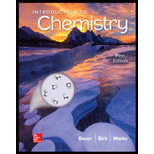
Concept explainers
(A)
Interpretation:
The number of moles of ions in
(A)
Explanation of Solution
The given balanced equation shows that one mole of
Therefore, the calculated moles of
Three moles of ions are dissolved in one mole
(B)
Interpretation:
The number of moles of ions in
(B)
Explanation of Solution
The given balanced equation shows that one mole of
Therefore, the calculated moles of
Three moles of ions are dissolved in one mole
(C)
Interpretation:
The number of moles of ions that dissolve in
(C)
Explanation of Solution
The given balanced equation shows that one mole of
Therefore, the calculated moles of
(D)
Interpretation:
The number of moles of ions in
(D)
Explanation of Solution
The given balanced equation shows that one mole of
Therefore, the calculated moles of
Three moles of ions are dissolved in one mole
(E)
Interpretation:
The number of moles of ions in
(E)
Explanation of Solution
The given balanced equation shows that one mole of
Therefore, the calculated moles of
Three moles of ions are dissolved in one mole
Want to see more full solutions like this?
Chapter 6 Solutions
INTRODUCTION TO CHEMISTRY(LL)-W/CONNECT
- The carbon dioxide exhaled in the breath of astronauts is often removed from the spacecraft by reaction with lithium hydroxide 2LiOH(s)+CO2(g)Li2CO3(s)+H2O(l) Estimate the grams of lithium hydroxide required per astronaut per day. Assume that each astronaut requires 2.50 103 kcal of energy per day. Further assume that this energy can be equated to the heat of combustion of a quantity of glucose, C6H12O6, to CO2(g) and H2O(l). From the amount of glucose required to give 2.50 103 kcal of heat, calculate the amount of CO2 produced and hence the amount of LiOH required. The H for glucose(s) is 1273 kJ/mol.arrow_forwardOxidation of 1.00 g of carbon monoxide, CO, produces 1.57 g of carbon dioxide, CO2. How many grams of oxygen were required in this reaction?arrow_forwardlist at least three quantities that must be conserved in chemical reactions.arrow_forward
- Nickel(II) sulfate solution reacts with sodium hydroxide solution to produce a precipitate of nickel(II) hydroxide and a solution of sodium sulfate. Write the molecular equation for this reaction. Then write the corresponding net ionic equation.arrow_forwardThere are many ionic compounds that dissolve in water to a very small extent. One example is lead(II) chloride. When it dissolves an equilibrium is established between the solid salt and its component ions. Suppose you stir some solid PbCl2 into water. Explain how you would prove that the compound dissolves but to a small extent? Is the dissolving process product-favored or reactant-favored? pbcl2(s)pb2+(aq)+2cl(aq)arrow_forwardA student is asked to identify the metal nitrate present in an aqueous solution. The cation in the solution can be either Na+, Ba2+, Ag+, or Ni2+. Results of solubility experiments are as follows: unknown + chloride ions—no precipitate unknown + carbonate ions—precipitate unknown + sulfate ions—precipitate What is the cation in the solution?arrow_forward
- Sodium thiosulfate, Na2S2O3, is used as a fixer in black-and-white photography. Suppose you have a bottle of sodium thiosulfate and want to determine its purity. The thiosulfate ion can be oxidized with I2 according to the balanced, net ionic equation I2(aq) + 2 S2O32(aq) 2 I(aq) + S4O62 (aq) If you use 40.21 mL of 0.246 M I2 in a titration, what is the weight percent of Na2S2O3 in a 3.232-g sample of impure material?arrow_forwardSeparate samples of a solution of an unknown soluble ionic compound are treated with KCl, Na2SO4, and NaOH. A precipitate forms only when Na2SO4 is added. Which cations could be present in the unknown soluble ionic compound?arrow_forward
 World of Chemistry, 3rd editionChemistryISBN:9781133109655Author:Steven S. Zumdahl, Susan L. Zumdahl, Donald J. DeCostePublisher:Brooks / Cole / Cengage Learning
World of Chemistry, 3rd editionChemistryISBN:9781133109655Author:Steven S. Zumdahl, Susan L. Zumdahl, Donald J. DeCostePublisher:Brooks / Cole / Cengage Learning General Chemistry - Standalone book (MindTap Cour...ChemistryISBN:9781305580343Author:Steven D. Gammon, Ebbing, Darrell Ebbing, Steven D., Darrell; Gammon, Darrell Ebbing; Steven D. Gammon, Darrell D.; Gammon, Ebbing; Steven D. Gammon; DarrellPublisher:Cengage Learning
General Chemistry - Standalone book (MindTap Cour...ChemistryISBN:9781305580343Author:Steven D. Gammon, Ebbing, Darrell Ebbing, Steven D., Darrell; Gammon, Darrell Ebbing; Steven D. Gammon, Darrell D.; Gammon, Ebbing; Steven D. Gammon; DarrellPublisher:Cengage Learning Chemistry: The Molecular ScienceChemistryISBN:9781285199047Author:John W. Moore, Conrad L. StanitskiPublisher:Cengage Learning
Chemistry: The Molecular ScienceChemistryISBN:9781285199047Author:John W. Moore, Conrad L. StanitskiPublisher:Cengage Learning ChemistryChemistryISBN:9781305957404Author:Steven S. Zumdahl, Susan A. Zumdahl, Donald J. DeCostePublisher:Cengage Learning
ChemistryChemistryISBN:9781305957404Author:Steven S. Zumdahl, Susan A. Zumdahl, Donald J. DeCostePublisher:Cengage Learning
 Chemistry: An Atoms First ApproachChemistryISBN:9781305079243Author:Steven S. Zumdahl, Susan A. ZumdahlPublisher:Cengage Learning
Chemistry: An Atoms First ApproachChemistryISBN:9781305079243Author:Steven S. Zumdahl, Susan A. ZumdahlPublisher:Cengage Learning





